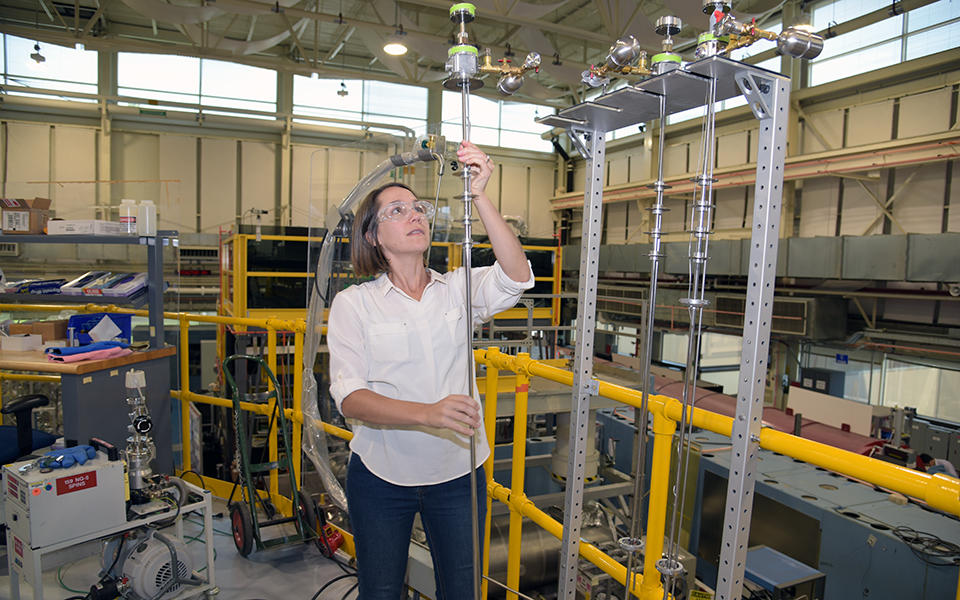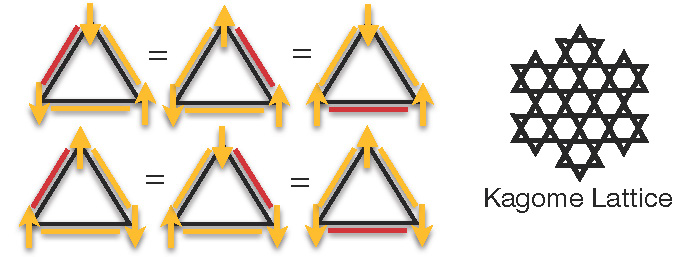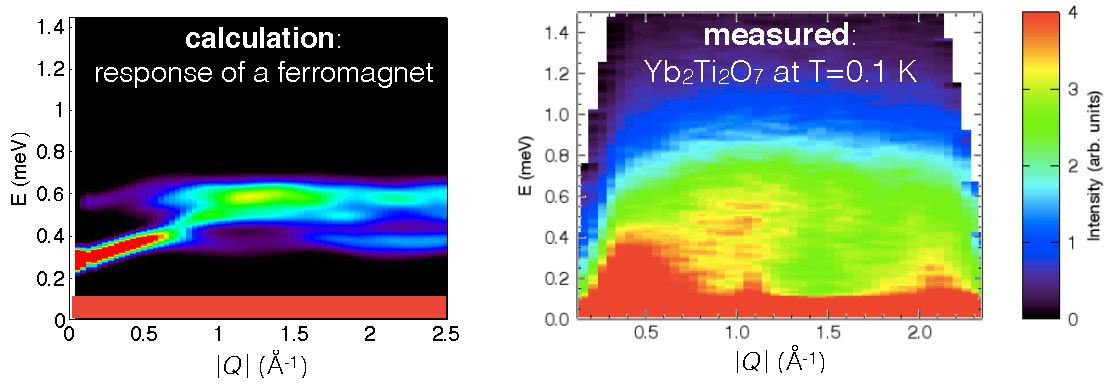Taking Measure
Just a Standard Blog

Here I am preparing to analyze a sample of a potential spin liquid material in the main hall at the NIST Center for Neutron Research.
There’s a pub here in Fort Collins, Colorado, that offers 100 different beers on tap. This sounds—and actually is—great, but it has a drawback. With so many different options, especially when all those choices are equally pleasing, it’s difficult to decide which one to get. This phenomenon is called “overchoice” in marketing: Too many options makes it hard for the consumer to choose, even if they are strongly motivated to drink that first beer.
Sounds frustrating, right? The funny thing is that something akin to this state happens in magnetic materials when their atoms’ electrons are given an impossible choice to make.
Spinning out of control
Without getting into all the various forms of magnetism, we can basically say that what usually sets magnetic materials apart is the fact that the spins of their atoms’ electrons are arranged in some repeating pattern, whether in harmony or opposition to each other or some combination of the two. The point is that there is a predictable pattern. The magnets that you probably have sticking to your refrigerator right now—ferromagnets—are magnetic because most all their electrons are spinning in the same direction, giving the overall material an orientation—north and south.
Theory, however, predicts that there is an as-yet-undiscovered phase of matter called a “quantum spin liquid” (QSL) in which the electrons’ spins, much like the molecules in a liquid, are random and remain so all the way down to absolute zero. In a QSL, electrons can’t seem to make up their minds about which way their spin points, the result being that they wobble confusedly—one might even say drunkenly—between the two states, a condition that we condensed matter physicists call “frustrated magnetism.”

Frustrated dreams
While the electrons may be unhappy with their situation, it turns out that their frustration would be a boon to scientists’ efforts to develop essential technologies for quantum computers. One of these technologies is “topologically protected” quantum bits. Quantum bits—or qubits—are quantum computers’ information processors, but these qubits are easily perturbed by outside influences. To make a topologically protected qubit, we could use the collective motion of our frustrated electrons to encode information in a way that does not care much about the environment. You can think of it like how a knot remains tied regardless of what might be tickling the ends of the string.
You might have noticed that I said frustrated electrons “would” be a boon to scientists and that we “could” use them. Now, it’s time to reveal the source of frustration to the scientists who look for these phases. While these phases of matter were first discussed over 40 years ago, we have yet to definitively observe such a state in a real material—though we have seen beautiful hints that it might be occurring in some materials. The search has recently intensified, and new ideas for where to look for QSL materials have multiplied. My research group at Colorado State University looks for QSLs and related states in magnetic materials using the powerful technique of neutron scattering, and as such, we are regular visitors to the NIST Center for Neutron Research (NCNR).
The neutron’s the thing
Neutrons make good probes of solid matter. They are electrically neutral, so they easily pass through large amounts of material, and their energies are widely tunable, making them well suited to study the excitations of a variety of types of materials. And, most importantly for me, they are sensitive to magnetism.
Neutrons from the reactor core are really hot and move really fast, but by passing them through room temperature water, or even a tank of liquid hydrogen if you really want to cool them off, they can be slowed down so that their wavelengths are comparable to the distances between atoms, about 0.1 nanometer. This means we can use them to determine the internal spatial and magnetic structure of crystalline and other materials. At the same time, their energies are comparable to typical excitations of magnetic materials, allowing us to easily see changes in the neutrons’ energies as they create these excitations. When we look at momentum and energy changes of neutrons after they interact with a solid, we can see signatures of the dynamics inside that solid. And it is this property that makes neutrons perfect for helping to identify the dynamic signatures of QSL states.
Taking a spin on the ice
QSLs are theorized to support “fractionalized excitations,” distinct collective motions of electron spins that are unstable and can break apart into two or more pieces. The QSL state is analogous to empty space (the “vacuum”) from which a variety of exotic quasi-particle excitations (the fractionalized excitations) with weird properties slip in and out of existence. Definitively showing the presence of such excitations in a real material would be the first step toward being able to manipulate these weird quasi-particles and possibly put them to work as quantum bits. We do have some strong candidate materials with neutron scattering signatures that suggest this type of excitation, the most famous of which is the mineral herbertsmithite, which was studied at the NCNR in 2012.
More recently, some very promising results include a possible magnetic field-induced QSL in a material called αRuCl3, as well as a class of materials known as “quantum spin ices.” The latter type of material is based on the “spin ice” state that was shown in the materials dysprosium titanate and holmium titanate to produce a quasi-particle analogous to magnetic monopoles, which are famously elusive in our universe (if they exist at all!). In quantum spin ice, that spin ice state is predicted to be modified by massive quantum entanglement, resulting in a QSL.
Luckily, cold neutrons, which are very slow, are perfect for probing the tiny energy scales that we think will reveal more QSL candidate materials. The NCNR is a great place to do this, in large part thanks to the National Science Foundation-supported Center for High-Resolution Neutron Scattering (CHRNS) program. Our work at the NCNR has shown that one quantum spin ice material, Yb2Ti2O7, displays an intriguing scattering “continuum” rather than the well-defined lines in energy-momentum plots we expect from conventional magnets, which could be due to fractionalized excitations.

A QSL in hand is worth a beer or two
With several new promising materials being introduced every couple of years, it’s clear that our refined techniques are bringing us tantalizingly close to definitively identifying a QSL. So, once we produce a material and definitively show that it hosts exotic fractionalized excitations, what is the next step?
We play with those excitations, of course!
I believe that’s when the not-yet-initiated field of “QSL-tronics” (hopefully, it will have a better name than that by then) will be born to try to control these emergent oddities, see how they behave and even try to make devices from them. Who knows what future quantum technologies could be developed once we have a QSL in hand?
It will probably be another lesson in overchoice as to which one to pursue at that point, but perhaps a beer will help me decide.
A scientist’s work is never done.






Professor Prem raj Pushpakaran writes -- 2023 marks the birth centenary year of Philip Warren Anderson!!!